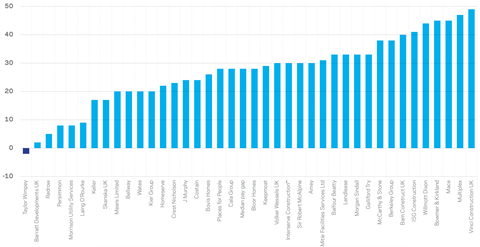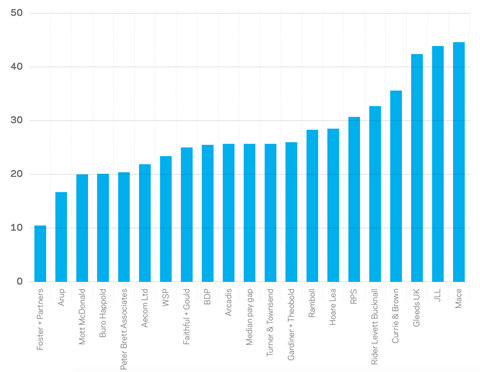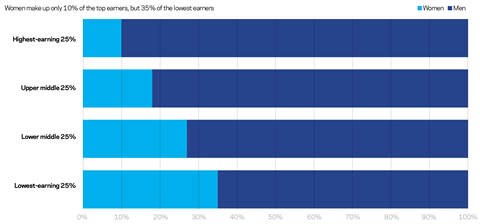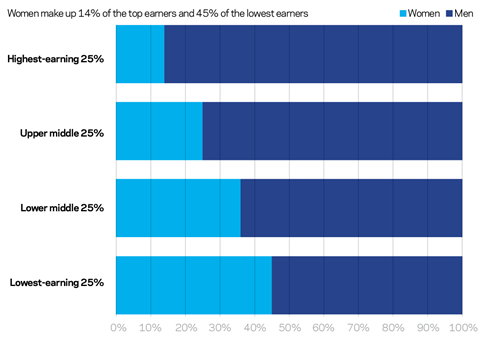The UK’s gender pay gap results are out and guess which sector performed worst? You got it – construction. Jamie Harris and Chloë McCulloch look at what the figures really mean, what people in the industry think about the results and how the gap can be closed

Two weeks after gender pay gap results hit the headlines, the construction industry is still coming to terms with being outed as the worst sector in the UK in terms of how little it pays women on average compared with men. We had always known that with barely 14% of the workforce being female, and even less when only construction roles are considered, there was a need to redress an imbalance. But now that we can view the disparity through the lens of pay, it appears even more shocking.
High-profile public reactions to the results of the pay gap reporting exercise have ranged from Theresa May’s description of “a burning injustice”, to the view that the data is essentially “meaningless” and even worse “misleading”, expressed by Kate Andrews of the Institute of Economic Affairs.
But despite the controversy over the usefulness of the data, at least we have some hard figures at last, and this being an annual event they will act as a benchmark to assess progress in the years ahead.
Here, we delve deeper into the numbers from the top construction firms to find out just how male-dominated they are across all levels of seniority, and we ask: how can the industry as a whole improve the gap – and its image – from such a lowly starting point?
What is the gender pay gap?
The gender pay gap is the difference in the average hourly wage of all men and women across a workforce. It is not the same as unequal pay – paying men and women differently for the same or similar work – which has been illegal since 1970.
All businesses with more than 250 employees have a statutory obligation to publish specific gender pay gap data and bonus pay gap data, as well as the percentage of women employed in each pay quartile.
Building has chosen to focus on the median gender pay gap, which is the middle number in a set of data, rather than the mean gender pay gap.
Some larger contractors have taken the opportunity to publish gender pay gap data for the entire group, as well as the divisions they are obliged to report on. Where possible, Building has used the whole group data.
To represent construction, Building has taken an average (median) of the median gender pay gap of the top 40 contractors and housebuilders in 2017, ranked by annual turnover. To represent consultancies, Building took an average of the top 20 consultancies in 2017, ranked by number of chartered UK staff.
The numbers


See the full gender pay gap data for the top consultants and contractors here
After the scramble to submit data ahead of the 4 April deadline – half the estimated 10,000 companies above the 250 employee threshold submitted in the final week – it has emerged that construction has the biggest gender pay gap, worse than the financial services sector, which came in second place, and the education sector, which had the third-biggest gap.
So just how bad is the situation really? Taking the 40 largest contractors and housebuilders listed in Building’s annual league table as a benchmark for the industry, there is big disparity between men and women’s average hourly wages – this is regardless of role or seniority. Women earn 72p for every £1 men earn per hour, which means they earn 18p less than the average pay gap figure reported for all sectors on the government’s official website.
“Women will now be saying to companies: ‘show us the steps you are taking to make the industry more attractive and the career paths that are open to us”
Theresa Mohammed, Trowers & Hamlins
About four-fifths of UK businesses reported a gender pay gap favouring men, but the situation in construction is even worse. Among the top 40 contractors and housebuilders only one firm, Taylor Wimpey, reported a negative gender pay gap – the housebuilder actually pays women 2p more on average.
Multiplex, Mace, Willmott Dixon, Bam and ISG were among the contractors to report a pay gap of more than 40% – they pay women on average less than 60p per hour for every £1 they pay men.
90p
When comparing median hourly rates across UK businesses, women earn 90p for every £1 that men earn
Men employed by the top 40 are also paid higher bonuses than women on average. For every £1 bonus paid to men in these firms, women get 53p on average, despite the average percentage of women receiving a bonus (57%) being similar to that for men (59%).
The largest consultants listed in Building’s annual league fared only marginally better than the contractors. Women working at these firms, including Mott MacDonald, Aecom and Arcadis, earn on average 74p for every £1 men earn. JLL and Gleeds were among the firms with the biggest discrepancy with women on average earning less than 60p for every £1 men earn, while Foster + Partners reported the smallest gender pay gap within the top 20 consultants – women earn just less than 90p to every £1 for men.
In terms of bonuses, while on average half of men receive a bonus compared with 40% of women, the gender bonus gap is slightly smaller than at contractors (32p less than the average bonus for men).


Underrepresentation
These statistics are undoubtedly of huge interest to current and future female employees of major construction firms – and anecdotally many women are now asking where they are positioned in the pay hierarchy – but they also have the potential to be a game-changer for a traditionally male-dominated industry.
Many argue the figures simply confirm what we already know: that construction has failed for a long time to attract women to its ranks and that only a fraction of the highest-paid roles are occupied by women. On average, one-quarter of employees in the top 40 contractors are female, as are nearly one-third of the top consultants’ employees.
But looking at the proportion of women in the upper quartile of workers – the highest-earning quarter of staff in a company – reveals a stark pay disparity between men and women. On average, nine in 10 of the highest earners in construction are men, while the gender split in the highest-earning quartile at consultants is only marginally better with women making up only 14% (see graphs above).
“The more attention we draw to this issue, the more likely we are to impact industry-wide change”
Lucy Homer, Lendlease
Most firms published a report alongside their gender pay gap figures to explain the results, and were often at pains to point out that the demographics of the industry in general puts individual companies at a disadvantage.
Laing O’Rourke – which is actually one of the best performers with a median gender pay gap of 8.8% – stated that the gap was driven by “a lack of female representation in senior management positions”, while Amey, with a 30% gap, explained that many of its higher-paying roles are in science, technology and engineering, where just 23% of roles nationally are held by women.
72p
When comparing median hourly rates across the top 40 contractors and housebuilders, women earn 72p for every £1 that men earn
But the counter argument is that it’s not enough for companies to simply describe the problems – the gender pay gap exercise is meant to prompt them to look for the reasons and to tackle them head on. And that frustration is echoed in the results of a reader survey conducted by Building during the week after the pay gap deadline. Only 13% of female respondents employed by firms with a plan to close the gap said the measures were sufficient. This compares with 50% of the male respondents who thought so. The survey also showed that only 45% of female respondents believe their firm has equal opportunities for the sexes, compared with 95% of male respondents (see full survey results online).
One respondent said: “I feel the ‘plans’ to lessen the gap are just token responses to show that companies will do something to tackle the issue. As one of the senior women staff in my company, I am not reassured enough to believe that my firm is indeed genuinely concerned about the gap.”
What the contractors said
Balfour Beatty – median gender pay gap: 33%
“In the last 12 months we have seen a welcome increase in the number of women joining each one of our UK business units, women we must now work hard to retain. In spite of these positive signs there is a still a long way to go. Beyond Balfour Beatty there must therefore be a wider collective effort to bring more women into the construction industry as a whole.”
Barratt – median gender pay gap: 1.22%
“Construction has traditionally been an industry with a majority male workforce and in our business 70% of the workforce is male. We are committed to improving the male/female ratio across our business and increasing the number of women in senior management positions, and we have an action plan in place to achieve this.”
Kier Group – median gender pay gap: 20.2%
“We need to challenge the misconceptions of our industry being muddy, manual and male-dominated if we’re to encourage a new generation to come and work with us. More diverse companies benefit from diversity of ideas, which leads to business success.”
Interserve Construction – median gender pay gap: 29.7%
“At Interserve we are committed to creating a diverse and inclusive workplace where all of our people feel at ease and can progress. We are also working on our approach towards attracting women to roles that have previously been identified as more male-dominated.”
Taylor Wimpey – median gender pay gap: -2%
“We have in place a number of initiatives aimed at increasing female representation in our business. Our focus is now on continuing this upward trend throughout the business and at all levels.”
Persimmon Group – median gender pay gap: 8%
“Opportunities to increase female representation at the most senior grades occur less frequently than we would like them to so it is very difficult to make a quick impact on the gender pay gap. However, only 13% of our current senior management team is female and the group will be looking for opportunities to increase this proportion wherever possible.”
Berkeley Group – median gender pay gap: 37.9%
“Recognising that the industry as a whole has an under-representation of women, cross-industry collaboration is key to raising the profile of the industry and to supporting women already in the sector.”
Morgan Sindall – median gender pay gap: 33%
“Going forward we are committed to addressing this imbalance and to achieving a year-on-year reduction in our gender pay gap.”
Amey – median gender pay gap: 30%
“A lot of our higher paid roles are in science, technology and engineering related careers. Only 23% of these roles are currently held by women in the UK. National figures show there are more women than men in lower paid and less technical jobs.”
Laing O’Rourke – median gender pay gap: 8.8%
“Our gender pay gap is largely driven by a lack of female representation in senior management positions; we are working hard to increase the number of women entering the industry and developing their careers through our talent programmes.”
Reputational damage vs good PR
Negative reactions to the gender pay gap results have the potential to inflict considerable reputational damage. While many firms are actively involved in trying to improve the image of construction and recruit more women, some believe this very exercise could set them back, dissuading women from joining firms that have poor data.
On this point one female respondent to our survey (from a company with less than 250 employees) said: “We considered publishing [pay data] even though we don’t have to, but decided not to as the measure is misleading and has been misrepresented by the media as if it measures equal pay.”
Worse, some think that it could put women off the industry altogether – one respondent said that the gender pay gap “makes the construction sector appear unattractive and unequal”.
“As one of the senior women staff in my company, I am not reassured enough to believe that my firm is indeed genuinely concerned about the gap”
Survey respondent
Howevever, others take the view that the data-trawling exercise has been the wake-up call the industry desperately needed. Theresa Mohammed, a partner at law firm Trowers & Hamlins and chair of the National Association of Women in Construction, argues that reporting the pay gap helps drive the long-term goal of greater diversity in construction.
She says: “If we get a lot more women and progress them through then the gap should get better. Women will now be saying to companies: ‘show us the steps you are taking to make the industry more attractive and the career paths that are open to us’.”
Lendlease (with a gap of 33%) was one of the high-profile contractors to embrace the process by publishing its results six months before the deadline. Lucy Homer, an executive general manager at Lendlease, says the decision was made to raise awareness: “The more attention we draw to this issue, the more likely we are to impact industry-wide change.”
74p
When comparing median hourly rates across the top 20 consultants, women earn 74p for every £1 that men earn
Six months on, the firm says it is continuing to ramp up its efforts. Homer says: “We have a series of robust measures in place to ensure we recruit women and, crucially, support them so that they stay and move up the ranks. These include a 50:50 gender mix graduate intake, a requirement that all candidate shortlists include women and unconscious bias training. We also have a 50:50 target for Lendlease’s Future Leaders programme and are running a female development scheme.
“I am hoping this is a turning point at which the whole industry looks to change its attitudes towards gender.”
Taylor Wimpey (-2%) has also used the pay gap reporting to point to a series of initiatives it runs, aimed at increasing female representation in the business, such as its annual graduate recruitment scheme and Supporting Female Talent programme. The firm’s female representation in the highest pay bracket is 36%, considerably above the industry average. It stated: “Our focus is now on continuing this upward trend throughout the business and at all levels.”
And it’s not just the firms obliged to report the pay data that see the advantages to being open about the pay gap. More than 200 small firms across the UK have reported their pay gap data voluntarily. Ben Derbyshire, president of the RIBA – which itself reported its data voluntarily – has urged small architectural practices to report theirs too, saying: “I encourage practices with fewer than 250 staff to follow suit.”
Ryder Architecture, a practice with 182 staff across the UK, decided to share its gender pay figures internally, and has claimed that it “does not have any gender pay gaps between graduate and architectural director grades”.
Helen Whitfield, communications director at Ryder, says all businesses have a moral obligation to tackle the gender pay gap. She says: “Every-sized business has a duty to reflect and understand how it can improve in this area to reinvent the industry. Transparent communication is fundamental.”
The pressure is now on to turn good intentions into actions. Many firms are already setting out strategies – as seen in their pay gap statements – from promoting flexible working for women and men to mentoring programmes.
Dawn Moore, HR director at Morgan Sindall, is confident that creative initiatives can make a difference. She says: “Programmes such as our returnships scheme help us attract people with relevant skills and management level experience who have taken a voluntary career break of at least 18 months. These sorts of initiatives are key in attracting senior professional women, men and working parents with huge amounts of valuable experience.”
A male partner at a top consultant, who did not wish to be named, says this desire to bring about rapid change also exists among consultants: “We are acutely aware of the need to address it [the pay gap] quickly and we are looking to bring women through as partners. I believe it would be a better place if more women were in senior positions. It’s probably a good time to be a woman [in our firm].”
The plethora of pledges from businesses committing to change are the first step of a long journey. Next April it will become clear whether any progress has been made.
Bonuses
| Upper quartile | Male % | Female % |
|---|---|---|
| UK-wide | 61 | 39 |
| Top 40 contractors | 90 | 10 |
| Top 20 consultants | 86 | 14 |
| % who received bonus | Male | Female |
|---|---|---|
| UK-wide | 36 | 34 |
| Top 40 contractors | 59 | 57 |
| Top 20 consultants | 50 | 40 |
| Median bonus gap | |
|---|---|
| UK-wide | -14% |
| Top 40 contractors | 46% |
| Top 20 consultants | 32% |
The bonus pay gap doesn’t tell the whole story. Contractors have been quick to note that bonuses are often linked to certain parts of the business, which have historically been male-dominated. Homer says: “With bonuses tending to be given to those in more senior roles, the dearth of women in the industry’s upper ranks looks to be the main cause of the gender gap in bonuses.
“Programmes we have in place are already improving things, but we want to do better. We are now targeting 33% by 2020 and are on track to do so.”
But Mohammed believes this is a grey area. She says: “The nature of bonuses being highly discretionary makes them ripe for difficulties, it can be hard to mount a claim on the grounds of discrimination or lack of parity. But in construction salaries are often heavily supplemented by bonuses, which are used to incentivise staff who can be being paid £20,000-£30,000 in bonuses, which could make all the difference.”



























No comments yet